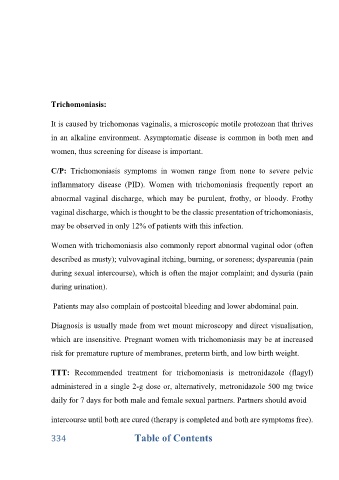Page 335 - Critical Maternity & Newborn Health Nursing
P. 335
Trichomoniasis:
It is caused by trichomonas vaginalis, a microscopic motile protozoan that thrives
in an alkaline environment. Asymptomatic disease is common in both men and
women, thus screening for disease is important.
C/P: Trichomoniasis symptoms in women range from none to severe pelvic
inflammatory disease (PID). Women with trichomoniasis frequently report an
abnormal vaginal discharge, which may be purulent, frothy, or bloody. Frothy
vaginal discharge, which is thought to be the classic presentation of trichomoniasis,
may be observed in only 12% of patients with this infection.
Women with trichomoniasis also commonly report abnormal vaginal odor (often
described as musty); vulvovaginal itching, burning, or soreness; dyspareunia (pain
during sexual intercourse), which is often the major complaint; and dysuria (pain
during urination).
Patients may also complain of postcoital bleeding and lower abdominal pain.
Diagnosis is usually made from wet mount microscopy and direct visualisation,
which are insensitive. Pregnant women with trichomoniasis may be at increased
risk for premature rupture of membranes, preterm birth, and low birth weight.
TTT: Recommended treatment for trichomoniasis is metronidazole (flagyl)
administered in a single 2-g dose or, alternatively, metronidazole 500 mg twice
daily for 7 days for both male and female sexual partners. Partners should avoid
intercourse until both are cured (therapy is completed and both are symptoms free).
334 Table of Contents

